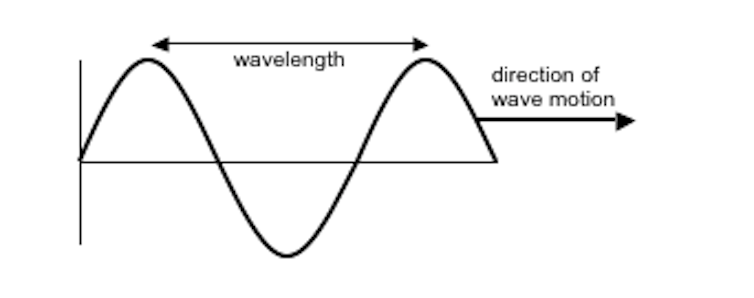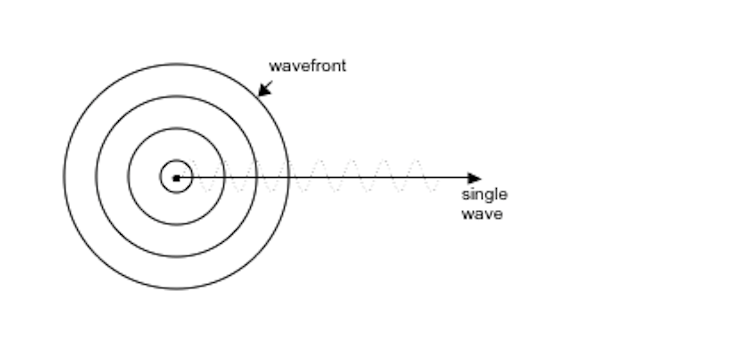what causes the pitch of a race car to get higher as it gets closer to you

Explainer: the Doppler effect
When an ambulance passes with its siren blaring, yous hear the pitch of the siren change: as it approaches, the siren's pitch sounds college than when it is moving away from you. This modify is a common physical demonstration of the Doppler effect.
The Doppler effect describes the change in the observed frequency of a wave when there is relative move betwixt the wave source and the observer. It was beginning proposed in 1842 past Austrian mathematician and physicist Christian Johann Doppler. While observing distant stars, Doppler described how the colour of starlight changed with the movement of the star.
To explain why the Doppler effect occurs, nosotros need to start with a few basic features of wave motion. Waves come in a variety of forms: ripples on the surface of a pond, sounds (as with the siren above), calorie-free, and earthquake tremors all exhibit periodic moving ridge motion.
2 of the common characteristics used to describe all types of wave motion are wavelength and [frequency](http://encyclopedia2.thefreedictionary.com/Frequency+(wave+motion). If you consider the wave to have peaks and troughs, the wavelength is the altitude between consecutive peaks and the frequency is the count of the number of peaks that laissez passer a reference point in a given time period.

When we demand to think well-nigh how waves travel in two- or three-dimensional space nosotros use the term wavefront to describe the linking of all the mutual points of the wave.
So the linking of all of the wave peaks that come from the indicate where a pebble is dropped in a pond would create a series of circular wavefronts (ripples) when viewed from above.

Consider a stationary source that'southward emitting waves in all directions with a constant frequency. The shape of the wavefronts coming from the source is described by a series of concentric, evenly-spaced "shells". Any person standing still virtually the source will encounter each wavefront with the same frequency that it was emitted.

But if the wave source moves, the pattern of wavefronts will look unlike. In the fourth dimension between i wave peak being emitted and the adjacent, the source volition take moved then that the shells volition no longer be concentric. The wavefronts volition bunch up (get closer together) in front end of the source as information technology travels and volition be spaced out (further autonomously) behind it.
Now a person standing still in front end of the moving source will observe a college frequency than before equally the source travels towards them. Conversely, someone behind the source will observe a lower frequency of wave peaks as the source travels away from it.

This shows how the motion of a source affects the frequency experienced past a stationary observer. A like modify in observed frequency occurs if the source is however and the observer is moving towards or away from information technology.
In fact, any relative motion between the 2 will cause a Doppler shift/ result in the frequency observed.
And so why do we hear a change in pitch for passing sirens? The pitch nosotros hear depends on the frequency of the sound wave. A high frequency corresponds to a high pitch. So while the siren produces waves of constant frequency, as information technology approaches u.s. the observed frequency increases and our ear hears a college pitch.
After information technology has passed us and is moving away, the observed frequency and pitch driblet. The true pitch of the siren is somewhere between the pitch we hear equally it approaches united states of america, and the pitch we hear as it speeds away.

For light waves, the frequency determines the colour we see. The highest frequencies of light are at the bluish end of the visible spectrum; the everyman frequencies appear at the reddish end of this spectrum.
If stars and galaxies are travelling abroad from us, the apparent frequency of the light they emit decreases and their colour will move towards the red end of the spectrum. This is known as red-shifting.
A star travelling towards us will announced blueish-shifted (higher frequency). This phenomenon was what start led Christian Doppler to document his eponymous result, and ultimately allowed Edwin Hubble in 1929 to propose that the universe was expanding when he observed that all galaxies appeared to be blood-red-shifted (i.e. moving away from us and each other).
The Doppler issue has many other interesting applications across sound effects and astronomy. A Doppler radar uses reflected microwaves to make up one's mind the speed of distant moving objects. It does this by sending out waves with a particular frequency, and and then analysing the reflected wave for frequency changes.
It is applied in weather condition observation to characterise cloud movement and weather condition patterns, and has other applications in aviation and radiology. It's even used in police speed detectors, which are essentially minor Doppler radar units.
Medical imaging also makes use of the Doppler outcome to monitor blood flow through vessels in the torso. Doppler ultrasound uses high frequency sound waves and lets u.s. measure out the speed and management of claret catamenia to provide information on blood clots, blocked arteries and cardiac function in adults and developing fetuses.
Our understanding of the Doppler effect has allowed united states of america to learn more about the universe we are function of, measure the world effectually u.s. and look inside our own bodies. Future development of this cognition – including how to reverse the Doppler issue – could pb to technology once but read about in science-fiction novels, such as invisibility cloaks.
See more Explainer articles on The Chat.
Pembaca kami
Jumlah pembaca The Conversation sebanyak 18 juta pengguna setiap bulan, dan melalui Creative Eatables republikasi menjangkau 42 juta pembaca.
Mau menulis?
Tulis artikel dan bergabung dengan komunitas akademisi dan peneliti yang terus tumbuh dengan lebih dari 144.300 dari 4.343 lembaga.
Daftar sekarang
butlermovenciought.blogspot.com
Source: https://theconversation.com/explainer-the-doppler-effect-7475
0 Response to "what causes the pitch of a race car to get higher as it gets closer to you"
Post a Comment